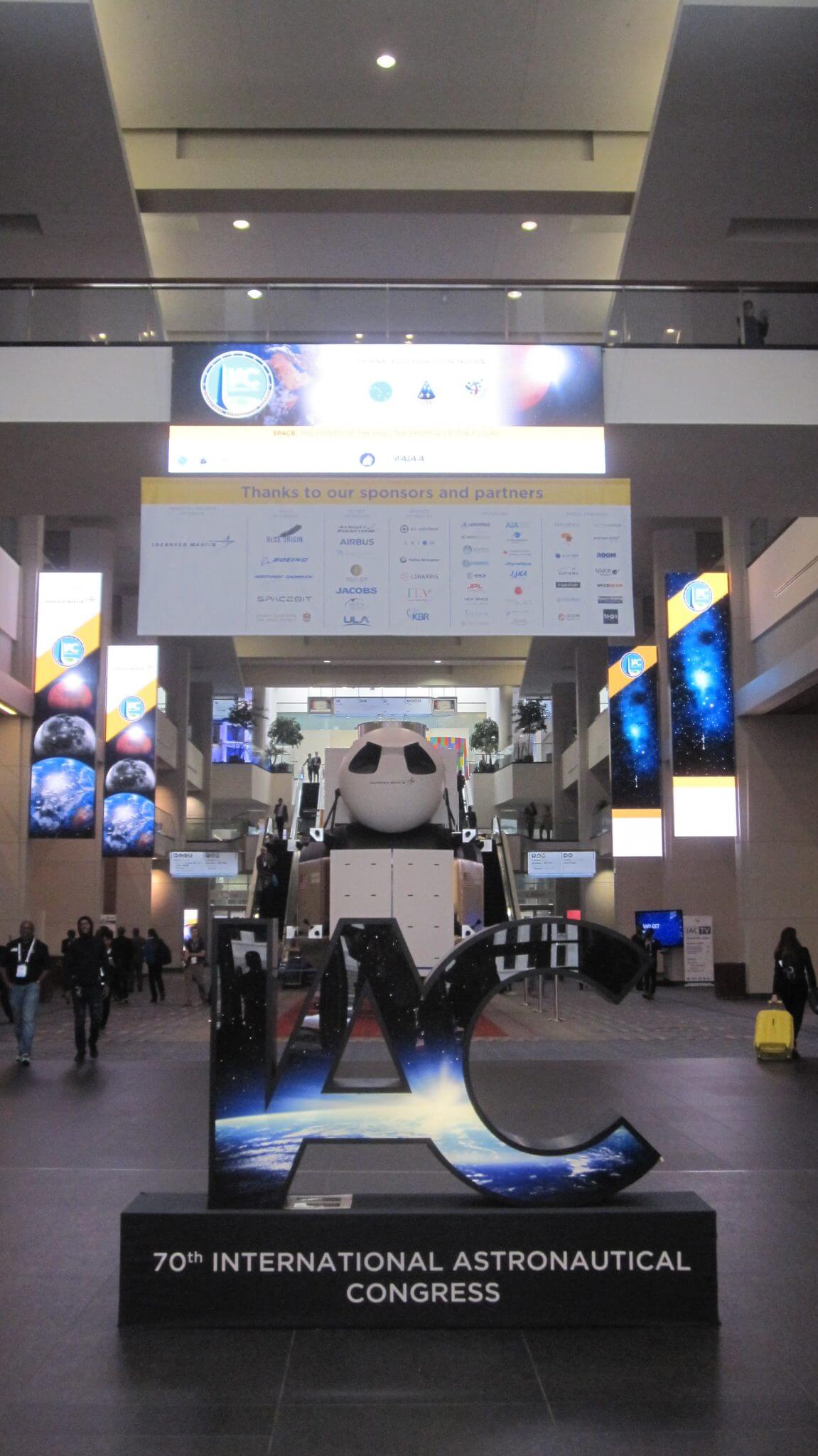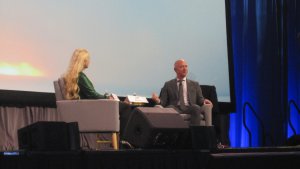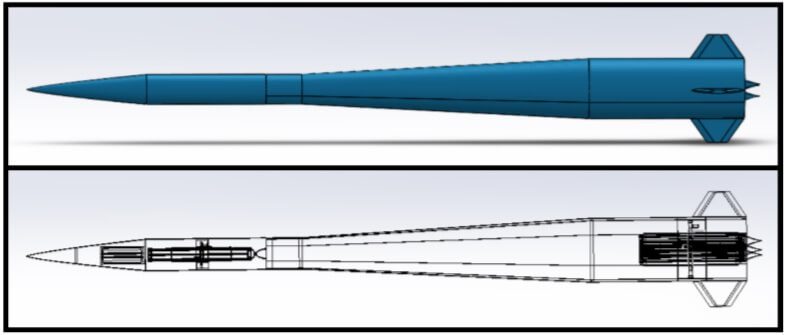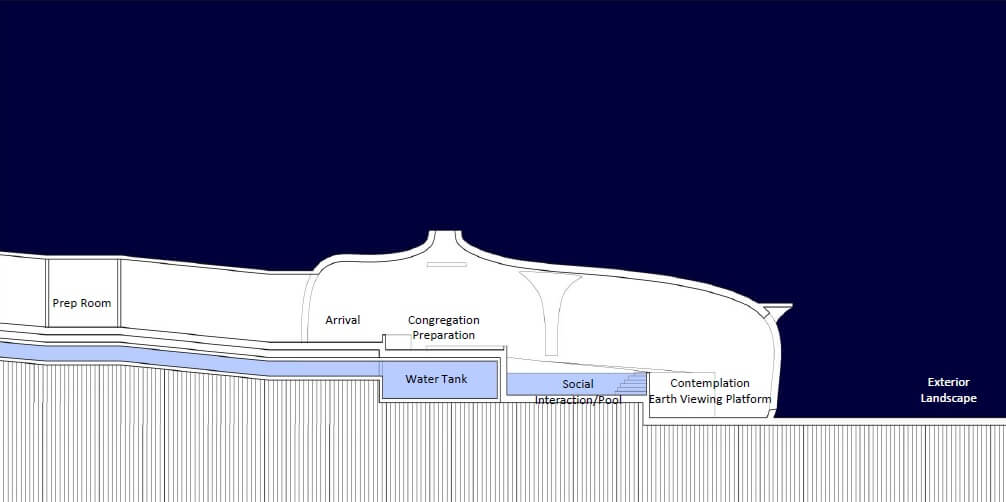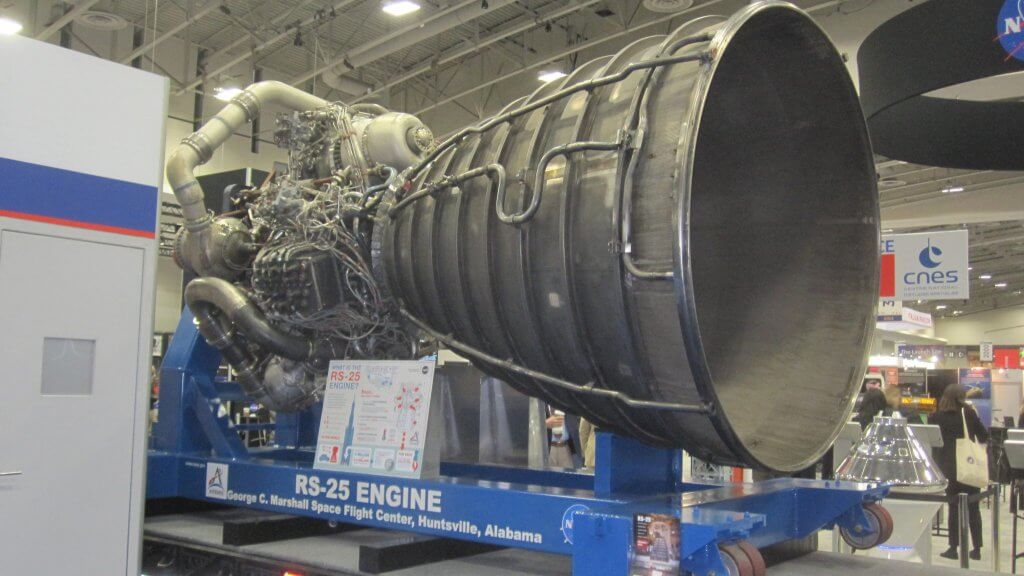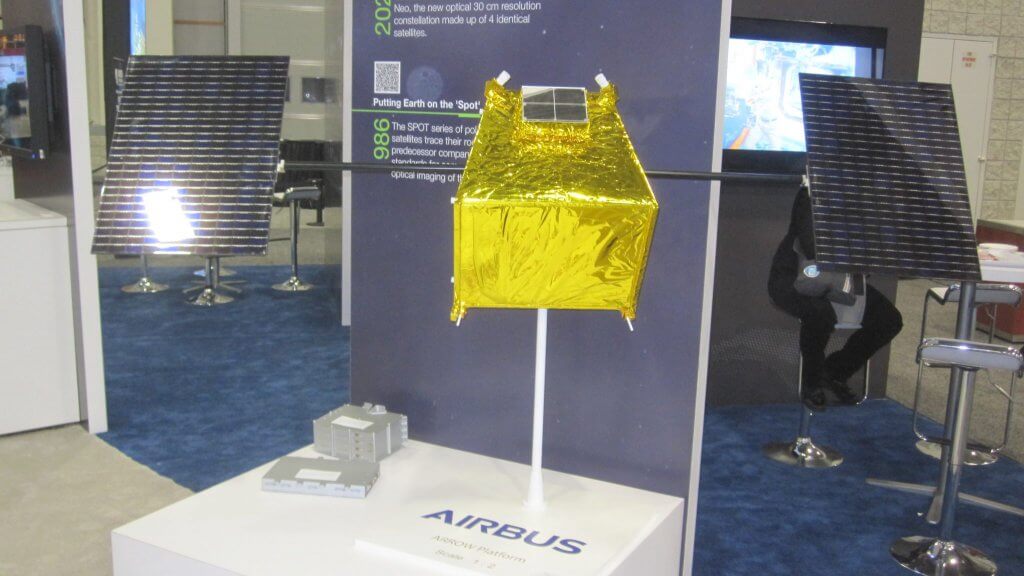The 70th International Astronautical Congress (IAC 2019) was held in the US Capital Washington DC during October. One advantage of the event being held in a “mainline” capital city – rather than the much smaller city of Bremen last year and Adelaide the year before that – is that it has excellent transport connections encouraging many participants to come. The downside is that it is expensive to stay in. Hotel room rates near the Walter E. Washington Convention Center were more than US$200 a night. It was not surprising that some preferred a short-term rent via AirBnB etc.
Washington, of course, has its own attractions and for space aficionados this means the Air and Space Museum of the Smithsonian. In the central museum about half the main galleries were closed for refurbishment, but fortunately the main space exhibitions were open including a good one detailing the history of the space shuttle.
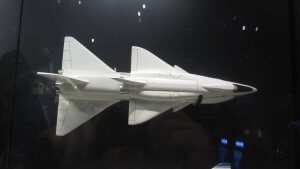
Original “both stages reusable” concept for the Space Shuttle on show at the Smithsonian. Courtesy: Seradata/David Todd
An impressive venue but Elon was missing
The Walter E. Washington venue (the name being a coincidence) was very good with spacious lecture rooms and an excellent main ballroom to hold the larger plenary and Global Networking Forum (GNF) sessions.
The big players – NASA, Boeing, Lockheed Martin, Northrop Grumman et al – were all in attendance both at the presentations and in the exhibition hall. But one Elephant not in the room was SpaceX, which was surprisingly not exhibiting at all and had few technical presenters.
While Elon Musk has stolen the IAC show before, most notably when he laid out his Mars exploration plan at IAC 2015 Guadalajara, his absence this year might have been because his competitor Jeff Bezos was being honoured for his achievements in spaceflight, even though Bezos has yet to orbit anything – possibly a case of premature congratulation. Bezos used the occasion to announced his new National Team to build a lunar lander/ascent vehicle (see separate story).
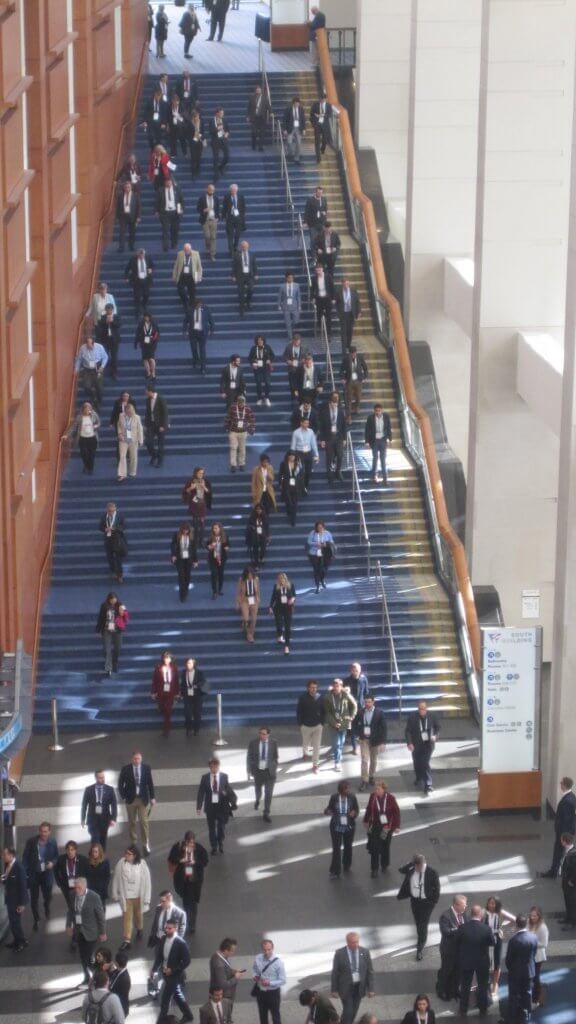
Attendees march down the main staircase after one of the main IAC 2019 plenary sessions. Courtesy: Seradata (David Todd)
The Opening Ceremony: Buzz is praised but Pence causes discord
The ceremony was the usual mixture of entertainment and a few tedious speeches from the officials of IAF, AIAA and main sponsors (Lockheed Martin). A video presentation of historical space achievements through the decades was impressive, even though some surprising “achievements” were noted, including the failed Conestoga launch vehicle – the first ever private launch. Another surprising inclusion was the failed German-African OTRAG project.
Among all the usual announcements and a welcome from IAF President Jean-Yves Le Gall, a standing ovation was given to Apollo 11 moon walker Buzz Aldrin and to relatives of his crew mates Neil Armstrong and Mike Collins in this 50th year after the lunar landing.
Musical actors provided the entertainment, taking time out from Broadway. They sang various Disney numbers and the hippy astrological hymn “This is the age of Aquarius” from Hair. Kind of old school, but kind of cool nonetheless. NASA astronaut Buzz Aldrin later mentioned this song in his thankyou speech as he noted that his birthday was at the beginning of Aquarius in the astrological Calendar. “My mother had no idea”, he said. By the way, on that foretelling theme, Buzz’s mother’s maiden name was “Moon”. Our Buzz wished NASA’s new lunar landing project Artemis well, albeit pointedly noting that it could be improved and that he would try to help.
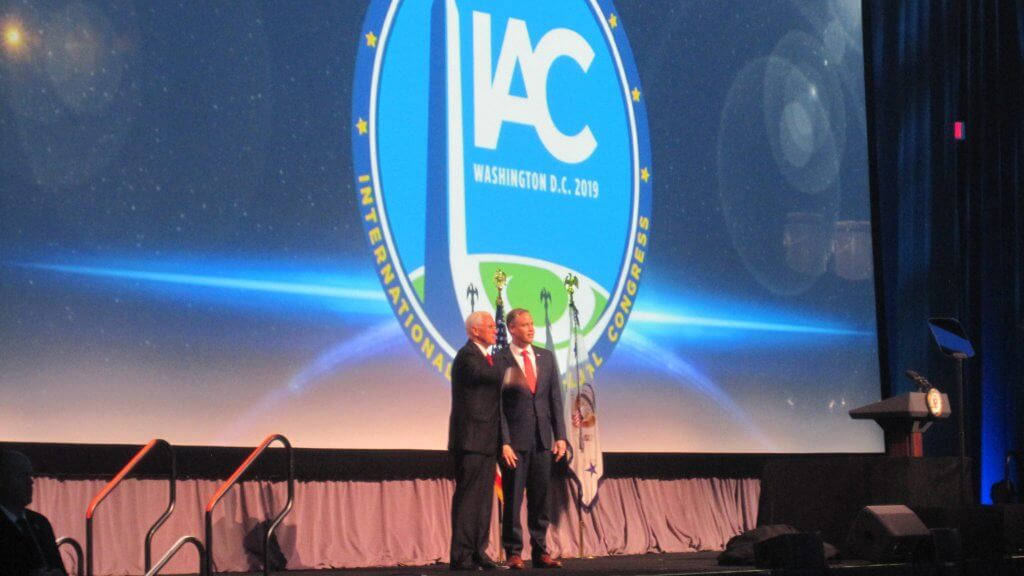
US Vice President Mike Pence next to NASA Administrator Jim Bridenstine. Courtesy: Seradata (David Todd)
NASA administrator Jim Bridenstine, having paid tribute to the first “unmanned” spacewalk – actually, an all-female EVA – introduced his boss, US Vice President Mike Pence. From the outset, Pence misread IAC’s international audience as he assumed an overtly political and nationalistic tone. He mentioned US President Donald Trump several times, saying: “Under Donald Trump’s leadership America is leading in Space once again.” He underlined the reconstitution of the National Space Council and said that the Administration now had a space policy directive number one: to return to the Moon to ensure that the next man and the first woman would both be American astronauts. He went on to describe plans to land on the Moon, travel to Mars and provide a successor to the International Space Station (ISS), and how commercial firms would be key partners.
Pence quoted President Trump again, saying: “It is America’s destiny to become leader among nations on our adventure into the great unknown.” He further antagonised the audience by noting that the USA would only take “Freedom Loving Nations” with it for the ride. While this notion might have some moral merit – let’s face it who would want to work with any modern-day equivalent of Nazi Germany on a space programme – from subsequent questions raised by the audience it became obvious that they had become quietly incensed that Pence had, in effect, announced yet another hurdle to international cooperation. As it was, the questions about what a “Freedom Loving Nation” is, and who is entitled to make this judgement…remained unanswered.
Having been far too nationalistic for much of his speech, Pence did his best to make amends by reassuring the audience that the USA and its new US Space Force would help to uphold international law. Belatedly, he also noted US gratitude to its international space partners: “Thank you for working with us”, he said. However, by then, the diplomatic damage had already been done.
Heads of Space Agencies Plenary: Private vs Public and lunar aspirations dominate
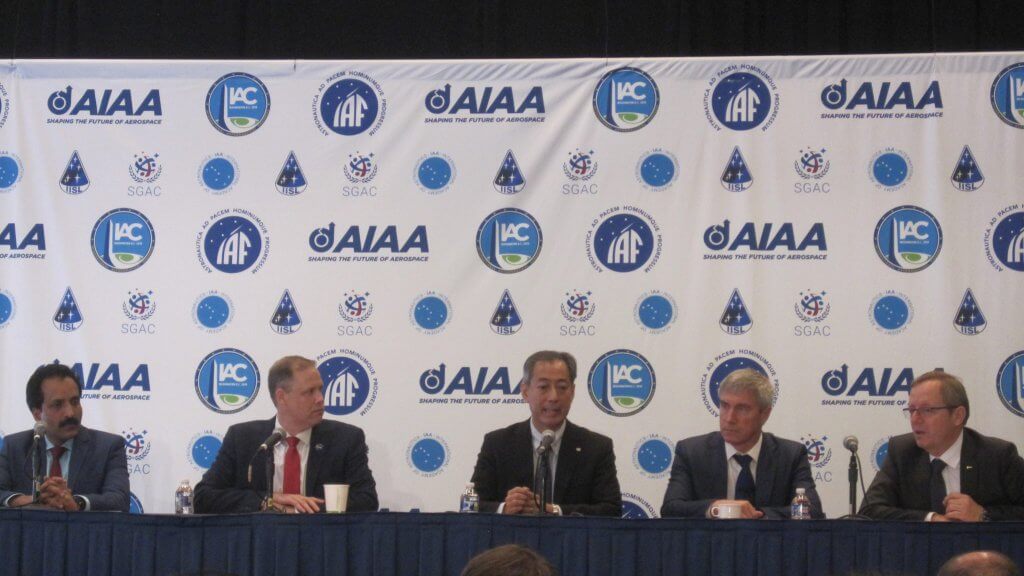
Head of Agencies press confererence: Left to right: S. Somanath (ISRO), Jim Bridenstine (NASA), Hiroshi Yamakawa (JAXA), Sergei Krikalev (Roscosmos) and Jan Woerner (ESA). Courtesy: Seradata (David Todd)
Jim Bridenstine (NASA) opened the batting by trying to make amends for Vice President Pence’s earlier speech by emphasising the role of NASA’s international partners.
In response to an audience question about China’s apparent absence from the Congress, Bridenstine unconvincingly covered for the Administration by explaining that no senior representative of China’s space programme was on the panel because a “time conflict” had prevented this. If so, what about all the other Chinese technical session presenters who were also missing? In truth, this was down to US visa restrictions and was part of the reason for international disquiet.
Bridenstine was on safer ground when he noted that he looked forward to the lunar operations and explained that the Gateway (commonly known as the Lunar Gateway) would have quite a long career of 15 years.
He emphasised that there would be astronauts from several nations walking on the Moon, albeit not on the early flights. There is an underlying keenness among the major agencies to join the US-led Project Artemis because all want to get one or two of their own nations’ astronauts onto the Moon. Canada and Japan have recently joined the programme with ESA expected to join shortly. With respect to what law would apply on the Moon, he called for an international agreement on a legal framework for lunar surface operations.
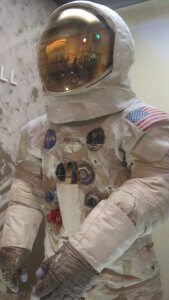
First Moonwalker Neil Armstrong’s space suit is proudly displayed in the Smithsonian Air and Space Museum – but how long will it be before another flag is on a Moonwalker’s shoulder? Courtesy: Seradata (David Todd)
Whether China, Russia, or even India, are deemed to be “Freedom loving” enough to have their respective taikonauts, cosmonauts or gaganauts carried there by the USA, remains to be seen. Either way, Russia and China are planning to join their efforts up on unmanned lunar missions with a cooperation deal already signed between the pair in September.
Bridenstine, a supporter of commercial input into the NASA programme, again mentioned the potential for this on the US Space programme, covering up his irritation with Commercial Crew Programme delays as he did so.
Jan Woerner, ESA Director General, looked forward to the ESA member states’ meeting in November when he hopes to get his programmes’ funding through. In balancing the private/public elements of his space programme, Woerner said that it was right to “celebrate the past” but also wise to “prepare for the future”. In some sectors private commercial companies now had the lead over agency or government programmes, but that some areas would still be led by national and international programmes, he added.
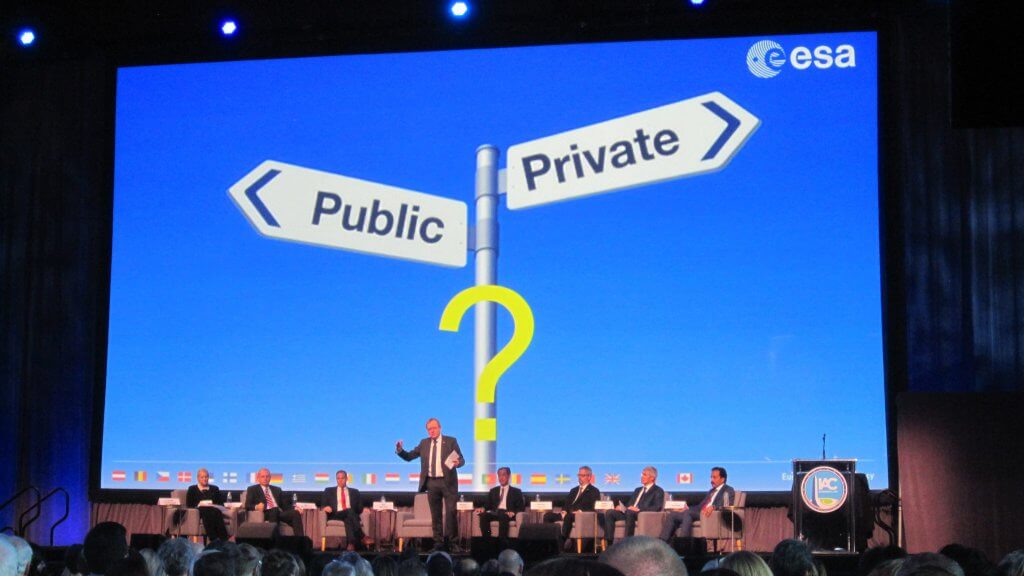
ESA’s Jan Woerner makes his point about the role for public and private funding. Courtesy: Seradata (David Todd)
Hiroshi Yamakawa, President of Japanese space agency JAXA, mentioned recent Japanese space exploration successes, including Hayabusa 2, and noted plans including the asteroid mission MEMO, which is being done in conjunction with ESA. Japan also hopes to take part in the USA’s Artemis programme, as did Silvain Laporte, President of the Canadian Space Agency, who, in addition to its Quantum Key Distribution research, mentioned the new robotic arm dubbed Canadarm 3 for the Gateway system.
While Dmitry Rogozin, Head of the Russian Space Agency/conglomerate Roscosmos, is barred by international sanctions from travelling to the USA, at least his deputies could still come. Filling in for him was former cosmonaut Sergei Krikalev, head of Roscosmos’s Human Spaceflight programme. He emphasised current international cooperation, citing the use of Russian launch vehicles in French Guiana. Krikalev mentioned Roscosmos’s hopes to take part in Project Artemis – it wants to build landing craft for use from the Lunar Gateway.
Jan Woerner explained that space technology remained very important to the fight against climate change, providing the example that new navsat algorithms could show up the “greenest” routes for cars and aircraft in addition to the fastest ones. He also called for more data sharing to help combat climate change.
While Bridenstine covered for the Trump Administration over its antipathy to China, he still pointedly disagreed with its climate change scepticism and specifically mentioned the new NASA GeoCarb mission to study carbon footprints on Earth.
S. Somanath, head of the propulsion effort at ISRO, having paid tribute to the Chandrayaan 2 partially successful lunar mission, set out ISRO’s plans including the MOM-2 mission to the Sun, as well as the introduction of its new small launcher the SSLV. Echoing Woerner, he also noted that PSLV marketing and operations might one day be transferred to private companies but that this would be a step-by-step process. India is currently working on its own human carrying spacecraft, even if many wonder how this part of its space programme will help the country’s poor. India defends its right to do this, although it views sending its own space-farers to the Moon as a very distant prospect.
The Technical presentations: Microlaunchers, Moon Baths and Mexico!
There are, of course, so many technical presentations that this column cannot note them all. Of those that this correspondent saw, the following were interesting or memorable.
While lunar exploration dominated the technical sessions, some were still holding a flag in support of a Mars Direct mission. Robert Zubrin of the Planetary Society (IAC-19.D5.2.8) remains an admirer of Elon Musk’s Starship/Superbooster combination, but only as a heavy lift launch vehicle. He suggested that it would be better in terms of time and number of launches to launch a much smaller transfer and landing craft – probably in the form of a one sixth size “mini-Starship” launched towards Mars from a TLI (Trans Lunar Injection) orbit. Zubrin also dismissed the use of the full-sized Starship as a lunar lander as being totally oversized.
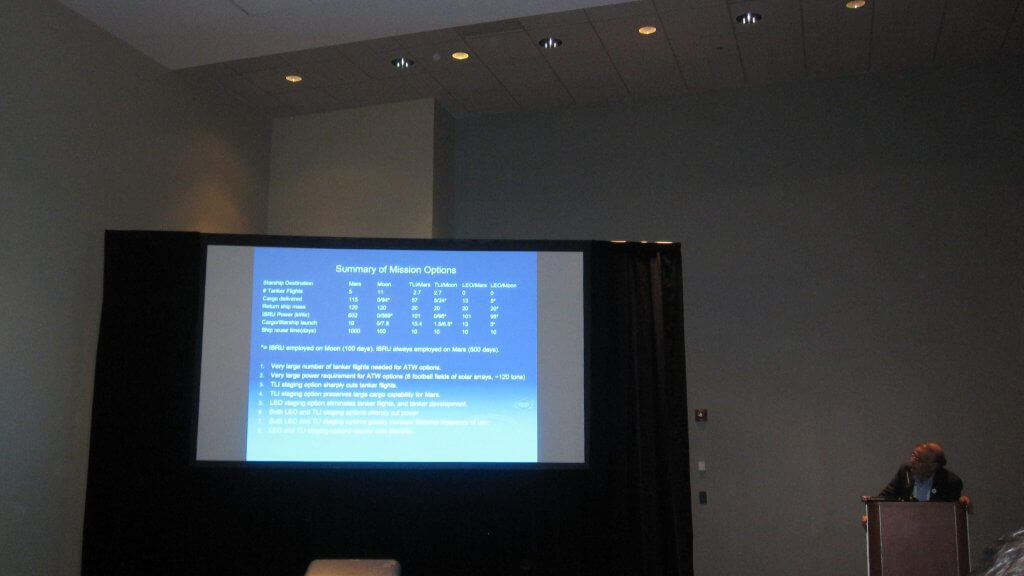
Robert Zubrin judges the options for using Elon Musk’s rockets for Mars. Courtesy: Seradata (David Todd)
On a different subject, while many are concerned that there are already too many small launch vehicles for the market to sustain, that did not stop more prospective vehicle designs being described at IAC.
Of these, the South Korean Blue Whale launch vehicle (IAC-19.D.2.7.5) is developing fast and looks likely to achieve a planned launch of a 50 kg payload to a 500 km Sun-synchronous low Earth orbit. By coincidence, the launches are to take place from near Whaler’s Way in South Australia. The rocket uses a CFRP structure with a flame-retardant resin. It was ruefully noted by presenter Dongyoon Shin, of Perigee Aerospace, that this latter requirement had been proven by empirically explosive results.
Of course. early launches are prone to failure, as space insurers will surely tell you. As such, it was not a surprise that the Landspace ZQ-1 private launch vehicle (IAC-19.D.2.7.7) failed due to a thruster leak on its second stage.
Virgin Orbit (IAC-2019.D.7.3) has its eyes on higher things as it plans a VIP (Virgin Interplanetary) third stage for its air-launched LauncherOne to be able to carry small payloads to the Moon and on to Venus and Mars including a 70 kg Venus probe for Poland in 2023.
And they are not the only small launch vehicles heading to the Moon. Rocket Lab has a new Photon stage for its Electron launch vehicle which will allow payloads to be carried there. The firm is also working on a reusable stage one using ballute balloons and parachutes with a re-entry test planned for November.
Meanwhile, a Mexican team led by Irving Enrique Gomez Fernandez presented a plan for a much smaller launch vehicle: their XITXIT 1 two-stage nano-launcher concept (IAC-19.D.2.7.4) which they hope to launch from Baja, California. This is a micro launcher employing an aerospike configuration with three nozzles on its first stage. And while it can carry only 6 kg to orbit, it can do so below the “magic” cost number of US$10,000 per kilo. If this price is right, then this concept deserves support – if only to prove whether, or not, aerospike nozzle altitude compensation can really work on a practical launch vehicle.
When it comes to new engine technology, IAC-2019.D.4.9.6 showed an interesting concept of using a rotating detonation ramjet technique for launch and airborne transportation use.
Insurers were in evidence at the Congress. Nishant Chokski, of Ares Advisers (IAC-2019.E6.4.4), noted the poor recent results in the insurance market as did Chris Kundstadter, of XL Catlin (IAC-2019.E3.6.7), who suggested that increasing the “power density” of spacecraft – putting more power generating capability in the same sized spacecraft – has had an effect on losses given that the majority of in-orbit claims were power related.
It was not just science, engineering and business issues in the technical sessions, there was a little real architecture as well with an “Age of Aquarius” new-age hippy theme thrown in. While there are considerable doubts about whether suborbital space tourism will ever pay for itself (Blue Origin and Virgin Galactic take note), the vibes about lunar space tourism are much more positive. Already, lunar hotel designs are taking shape, some envisaging making use of lava tubes on the Moon.
Madhu Thangavelu, of the University of Southern California, rushed though some of the potential designs in his paper IAC.D3.1.7. He foresaw some of these lunar hotels having bath houses and contemplation zones with window views of the Earth.
For while “skyclad” new-age types on Earth like to look up at the Moon as they contemplate life, the universe and everything, these same types (if they are rich enough to afford the trip) will probably want to look at the Earth from the Moon as well.
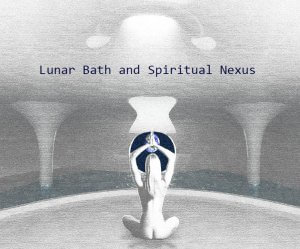
Lunar space tourism will need a bathhouse…and a contemplation zone. Courtesy: Mandhu Thangavelu (Univ. of S. California)
When it comes to the design of interiors an IAC special session panel on space architecture, including architects and astronauts, came to the conclusion that while white has long been a staple decor in science fiction, and is volumetrically enhancing, colour was essential for astronaut morale on long trips. Colour is also a good interior navigation tool on a large spacecraft. The panel also noted that the only architecturally designed part of the ISS was the viewing cupola which was also the most popular with the astronauts.
The panel agreed that growing plants in that life-versus-death context would also be beneficial to wellbeing, as would a low-noise environment. In space they might not hear you scream outside…but they will inside if annoying noise disturbs the astronauts too much.
The Exhibition: Plenty of rocket engines to see
The exhibition was quite large with an impressive collection of rocket engines, past and present, on display. Nevertheless, attendance at the exhibition seemed quite low mainly because the technical sessions were on the other side of the convention centre.
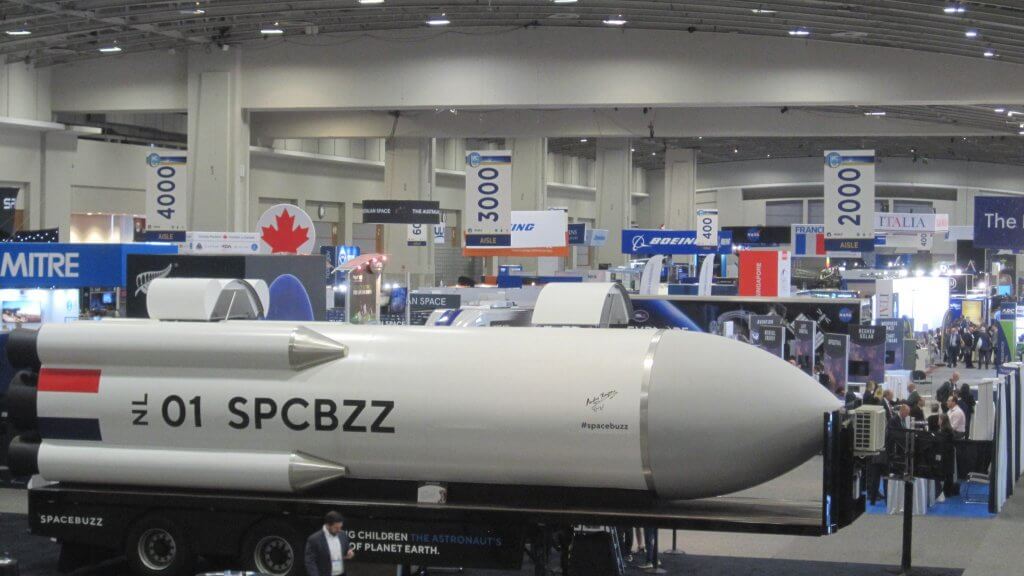
IAC 2019 exhibition in Washington DC was dominated at one end by a rocket shaped educational bus. Courtesy: Seradata (David Todd)
The welcome reception did its best to attract attendees to the exhibition hall, where it was held along with many smaller stand receptions. Nevertheless, the official main reception was unimpressive – with some not-very-good food, but at least it did not run out as so infamously happened in IAC Naples some years ago.
Of the real-life engines shown, a Space Shuttle Main Engine (SSME) now has new life as the RS-25D/E main lifting engine of the SLS. An original Apollo lunar lander’s ascent engine was also there as a blast-from-the-past reminder that reliability is still key for lunar flights.
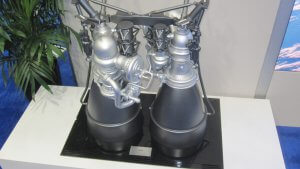
Model of AR1 engine assembly on display on the Aerojet Rocketdyne stand at IAC 2019 Washington DC. Courtesy: Seradata (David Todd)
There were also some newer designs on display including the Blue Origin BE-4 (albeit partially covered up) with which ULA hopes to launch its Vulcan rocket design, and a model of the Aerojet Rocketdyne AR-1.
While the AR-1 did not get the Vulcan selection as its first stage engine, it might yet get into flight mode on later models of the Firefly rocket series following a cooperation deal between Firefly and Aerojet. It was not just engines on display. There were some spacecraft models as well including several on the Airbus stand.
An educational bus/trailer dubbed SpaceBuzz dominated one end of the show as it allowed children to experience the virtual reality of space. Other stands supplied food and drink to up their attendance.
The UK Pavilion tried its best but looked a tad unimpressive compared with some. It really needed a much larger Union (Jack) flag on top of it.
On a lighter note: Pluto is a planet but always have your skateboard ready
Buzz Aldrin walked on the lunar surface back in 1969 but he had to make do with normal flooring at the IAC. Your correspondent pointed the veteran Apollo 11 moonwalker out to his friend as Buzz passed by. “Only at the IAC”, his friend said.
The Safran rocket engine supplier was keen to emphasise its space engine offerings, but you could tell that aviation was where its heart lay. The leaflets espousing the thruster designs had “aircraft engine” titled at the top of them.
While there may be plans to colonise the Moon and Mars, there was a sign that ‘civilisation’ has not quite yet reached the USA. There was no fresh milk for the admittedly free tea and coffee! Meanwhile, the tea that was available tended to be of the green, decaffeinated or flavoured kind. As such packets of English Breakfast and Earl Grey tea ran out very quickly, so it was soon coffee or bust for the punters.
The food outlets were just about OK – well, after Monday when more were opened. The washrooms at the convention centre were good…but the gaps at the toilet door bases are way too large. Watch out for any deranged limbo dancers passing by!
NASA head Jim Bridenstine proved to be a class act at diplomatic tightrope-walking, however there was one subject that he remained hard-line about: whether Pluto was a planet. “It is,” he adamantly said, noting that it had an atmosphere and moons. “By the way, I like there being nine planets,” he added.
While some considered the finer points of space propulsion and space transportation systems, others were keen to have theirs by their side, including this attendee with his trusty skateboard …possibly to make a quick getaway in case of tedium.
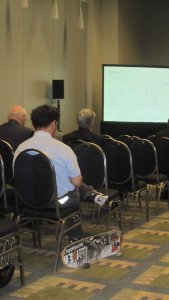
IAC 2019 participant with his trusty skateboard – ready for a quick getaway – by his side. Courtesy: Seradata (David Todd)
The best bit of the conference for this writer was when the Mexican pair who ended their excellent presentation about their XITZIT-1 aerospike rocket concept (yes, its name sounds like something you would rather squeeze than launch) with their clenched fists held high, and with their revolutionary cry of: “Viva Mexico!”
We take our hats off to them, but secretly wish that, for the full Mexican revolutionary effect, they had worn traditional sombreros as well, as Brit students like to do for fancy dress (well – until the killjoy politically correct student unions stop them).
The closing ceremony
The closing ceremony included student prizes given out by Gill Norman, Executive Secretary of the British Interplanetary Society (BIS). IAF gold medal winner and winner of the UK prize as well was Eleonor Frost, of University College London, for her paper “Investigating the Feasibility and Design of a Microgravity Surgical Workstation” (IAC-19.E2.2.6). She also won a £1,000 prize given by the BIS and IET, as did Thomas Cheney of Northumbia University, who won the UK prize for best postgraduate paper: “In the Interests of All Countries – Ensuring Equitable Access to Space Resources”(IAC-19.E2.2.5).
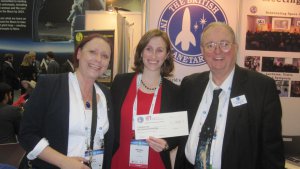
Eleonor Frost receives her “grand” from BIS Executive Secretary Gill Norman and BIS President Gerry Webb. Courtesy: Seradata (David Todd)
One final Brit student involvement to note was that of Edward Taylor of Birmingham University who was part of the University of Illinois at Urbana-Champaign team that won the Hans Von Muldau student team award for their paper related to detecting and suppressing any dangerous sharp edges on ISS EVA handrails caused by micrometeoroid impacts (IAC-19.E2.3-GTS.4.6).
Mind you, winning these prizes was small beer compared with the GL Launch Services prize awarded earlier to the students and staff at La Sapienza in Rome. They got a free Soyuz-2 launch ride worth circa US$50,000 for their animal tracking WildTrackCube – SIMBA (System for Improving Monitoring the Behaviour of Animals).
Christian Feichtinger, Executive Director of the IAF, noted the very large attendance of 6,800 delegates and thanked all his helpers. Jean-Yves Le Gall handed over the Presidential reins of the IAF (International Astronautical Federation) to the head of Germany’s DLR, Pascale Ehrenfreund, as Le Gall goes back to his day job of running the French Space Agency CNES.
While the next two years of IAC venues have been decided (IAF 2020 in Dubai, IAC 2021 in Paris), there was a competition for 2022. It may not always be profit making, but the Congress is such a venerated international event that many nations want it. Baku, Azerbajian, won the prize using its financial resources to beat off challengers Rio de Janeiro (Brazil), Delhi (India) and Singapore, via the promise of very low-cost student accommodation.
Conclusion: Overall IAC-2019 was a good event…but in many ways it has grown far too large. The GNF debating strand, while good at times, should never have been started.
Going back to the Moon was the main theme of this Congress as it will be the next target for human exploration – as perhaps it should have always been. Whether the limited US Artemis lunar programme is large enough for all the would-be international participants to get their astronauts onto the Moon remains to be seen.
There are, of course, some issues related to space (e.g. climate change, space debris, space and Moon law etc.) which are in everyone’s interest to solve. However, this IAC proved yet again that while global international cooperation in space is desirable, international politics can sometimes get in the way. NASA supremo Jim Bridenstine had his work cut out in trying to be as diplomatic as possible, given the differences between international space opinion (where his heart lies) and his bosses’ reluctant views about space cooperation and climate change (the USA has since formally started its exit from the Paris Climate Change agreement).
While there remains a legitimate concern about Chinese espionage and Russian belligerence, using visa restrictions to curb these major space powers’ access to this international space conference is still regarded by space and diplomatic circles as not the “done thing” to do. Even during the depths of the Cold War, most nations still had access to international discussion forums such as the UN and the IAC. That said, perhaps there should be limits to international cooperation, as doing this “at all costs” is not always morally the right thing to do.
Nevertheless, many of us would prefer it if the world leaders who deliver this uncomfortable message would appear to be a bit more reasonable and cooperative themselves – especially when international scientific evidence points the way.
We await IAC 2020 Dubai to see if things will improve.

